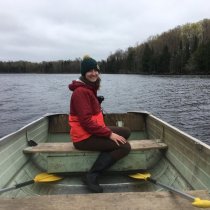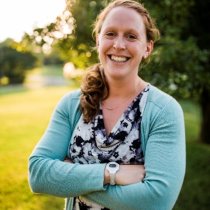Spotlight
Women to Watch in Ecology for 2021
February 25, 2021
In recent years, the persistence of gender disparities in STEM fields has become a concern for educators, research institutions, and commercial firms. Efforts to encourage girls and young women to pursue STEM education is improving the situation, with women earning half of all science and engineering bachelor's degrees since the late 1990s. However, retention and promotion of women in the STEM workforce remains a challenge—women still only comprise 29% of the science and engineering workforce, according to the National Science Foundation.
Through continental-scale and long-term standardized data collection and sampling, and through developing key resources for the science community, the National Ecological Observatory Network (NEON) presents a variety of research opportunities for women to pursue across scientific disciplines. Female scientists are carrying out groundbreaking research under the auspices of NEON datasets, which can inspire younger generations to further their interest in studying science, as well as pursue it professionally. NEON is committed to fostering innovative scientific inquiry not just now, but for decades to come. The program is dedicated to training and inspiring the next generation of scientists, and diversity will be a key feature of that generation as it leads the way in large scale open-sourced scientific data.
Our list of 'NEON Women to Watch' honors women we highlighted this past year whose educational and professional experiences provide a fascinating glimpse into women's paths in academic science, the crucial role of mentors and advocates in a student's development, and how the field can be more inclusive going forward. Be sure to keep an eye out in 2021 as they continue their journey of making invaluable contributions to ecology.
Stay tuned for more interviews with more amazing Women in Ecology!

Ana Bento
- Dr. Ana Bento, Assistant Professor in the School of Public Health at Indiana University, uses mathematical models, computational simulations, and statistical analysis to study the dynamics of infectious diseases at different spatial and temporal scales. Much of the work she does is framed by understanding optimal control strategies, like vaccination, which is the connection between pertussis, measles, and bovine tuberculosis. She is currently collaborating with other groups to understand how heterogeneity at the geographical level leads to different genomic signatures in the population, and how this might be useful in situations where testing is below necessary coverage levels.

Cayelan Carey
- Dr. Cayelan Carey, Associate Professor of Biological Sciences at Virginia Tech, specializes in freshwater ecology and ecosystem ecology. Carey's field work and data-intensive modeling approaches explore both how human activities affect freshwater ecosystems, and in turn how changing water quality modifies human decision-making.

Dana Chadwick
- Dr. Dana Chadwick, post-doctoral Research Fellow at Stanford University, specializes in Earth systems science. She believes that the future of environment and ecological sciences must be multidisciplinary and has drawn inspiration from critical zone science. Chadwick is looking forward to moving these ideas forward and using the NEON Airborne Observation Platform as a part of that.

Jennifer Cotton
- Dr. Jennifer Cotton, an Assistant Professor in the Department of Geological Sciences at California State University Northridge, specializes in paleoclimatic and paleoenvironmental reconstructions of terrestrial ecosystems. Cotton believes that interdisciplinary work is the future and has set out to continue bringing ecologists, geologists, and chemists together to gain a better understanding of the entire Earth system.

Nancy Glenn
- Dr. Nancy Glenn, Professor at Boise State University, focuses on remote sensing of the environment, dryland ecology and geological engineering. Glenn is currently in Sydney, Australia, to gain an international perspective in remote sensing and environmental science and engineering disciplines. She hopes to take a leadership role in international coordination of Earth observation and promote opportunities for the use of remote sensing to improve the livability of our planet for future generations.

Alexandra Harmon-Threatt
- Dr. Alex Harmon-Threatt, Associate Professor of entomology at the University of Illinois School of Integrative Biology, is pushing the field of pollination biology to consider soils more intensively. She aims to build a better modeling system for understanding native bees, since dominant models use honey bees, whose biology doesn't apply to most other bees.

Nyeema Harris
- Dr. Nyeema Harris, Assistant Professor at the University of Michigan, works in conservation biology with lions and large carnivores, community ecology, urban ecology, and global change biology. She aspires to establish a research center in West Africa – an area of the world with limited scientific capacity – to promote global scholarship and launch a nonprofit for communities of color with information about wildlife and the outdoors.

Monica Papes
- Dr. Monica Papes, Assistant Professor and Spatial Analysis Lab Director at the University of Tennessee Knoxville, investigates the potential effects of climate change on species' distributions. Papes hopes to integrate local scale environmental predictors into broad scale estimates of biodiversity distribution.

Sydne Record
- Dr. Sydne Record is an Associate Professor of Biology at Bryn Mawr College whose research incorporates field-based ecology, statistics, and computer modeling to determine what processes affect biodiversity across a wide range of spatiotemporal scales. Record is currently co-directing the Summer Research Program in Ecology at Harvard Forest. She aspires to remain in a leadership position to create pathways for women to establish their careers.

Angela Strecker
- Dr. Angela Strecker, Associate Professor and Director of the Institute for Watershed Studies at Western Washington University, supports student and faculty research, and monitors drinking water for the city of Bellingham, WA. Strecker is striving to advance ecological science by looking at the big picture and scaling up from local levels—for example, moving from a single NEON site to studying ecosystems at larger scales over time and space to get a better understanding of what is driving changes.



